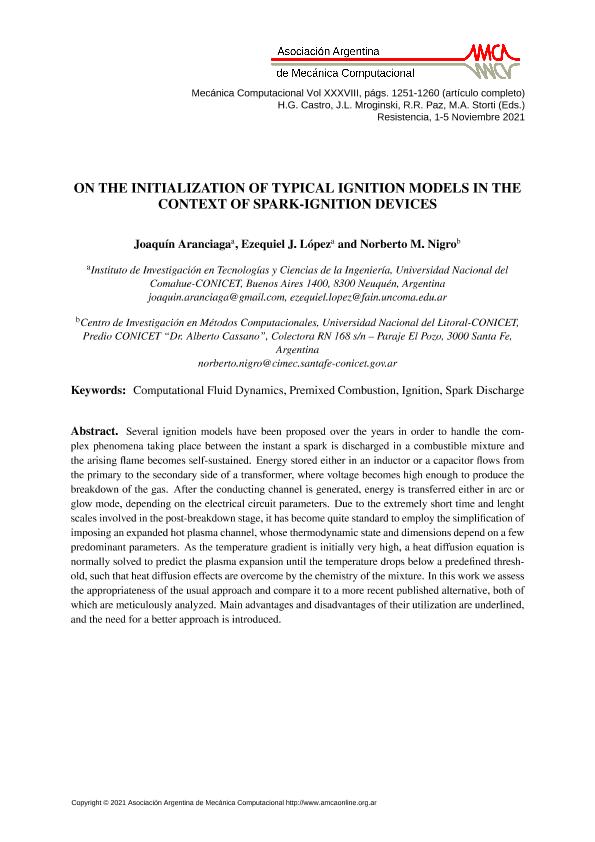Mostrar el registro sencillo del ítem
dc.contributor.author
Aranciaga, Joaquín

dc.contributor.author
Lopez, Ezequiel Jose

dc.contributor.author
Nigro, Norberto Marcelo

dc.date.available
2023-09-26T17:51:45Z
dc.date.issued
2021-11
dc.identifier.citation
Aranciaga, Joaquín; Lopez, Ezequiel Jose; Nigro, Norberto Marcelo; On the Initialization of Typical Ignition Models in the Context of Spark-Ignition Devices; Asociación Argentina de Mecánica Computacional; Mecánica Computacional; 11-2021; 1-10
dc.identifier.issn
2591-3522
dc.identifier.uri
http://hdl.handle.net/11336/213119
dc.description.abstract
Several ignition models have been proposed over the years in order to handle the complex phenomena taking place between the instant a spark is discharged in a combustible mixture and the arising flame becomes self-sustained. Energy stored either in an inductor or a capacitor flows from the primary to the secondary side of a transformer, where voltage becomes high enough to produce the breakdown of the gas. After the conducting channel is generated, energy is transferred either in arc or glow mode, depending on the electrical circuit parameters. Due to the extremely short time and lenght scales involved in the post-breakdown stage, it has become quite standard to employ the simplification of imposing an expanded hot plasma channel, whose thermodynamic state and dimensions depend on a few predominant parameters. As the temperature gradient is initially very high, a heat diffusion equation is normally solved to predict the plasma expansion until the temperature drops below a predefined threshold, such that heat diffusion effects are overcome by the chemistry of the mixture. In this work we assess the appropriateness of the usual approach and compare it to a more recent published alternative, both of which are meticulously analyzed. Main advantages and disadvantages of their utilization are underlined, and the need for a better approach is introduced.
dc.format
application/pdf
dc.language.iso
eng
dc.publisher
Asociación Argentina de Mecánica Computacional
dc.rights
info:eu-repo/semantics/openAccess
dc.rights.uri
https://creativecommons.org/licenses/by-nc-sa/2.5/ar/
dc.subject
COMPUTATIONAL FLUID DYNAMICS
dc.subject
PREMIXED COMBUSTION
dc.subject
IGNITION
dc.subject
SPARK DISCHARGE
dc.subject.classification
Ingeniería Mecánica

dc.subject.classification
Ingeniería Mecánica

dc.subject.classification
INGENIERÍAS Y TECNOLOGÍAS

dc.title
On the Initialization of Typical Ignition Models in the Context of Spark-Ignition Devices
dc.type
info:eu-repo/semantics/article
dc.type
info:ar-repo/semantics/artículo
dc.type
info:eu-repo/semantics/publishedVersion
dc.date.updated
2023-09-18T13:35:38Z
dc.journal.pagination
1-10
dc.journal.pais
Argentina

dc.journal.ciudad
Resistencia
dc.description.fil
Fil: Aranciaga, Joaquín. Consejo Nacional de Investigaciones Científicas y Técnicas. Centro Científico Tecnológico Conicet - Patagonia Norte. Instituto de Investigación En Tecnologías y Ciencias de la Ingeniería. Universidad Nacional del Comahue. Instituto de Investigación En Tecnologías y Ciencias de la Ingeniería; Argentina
dc.description.fil
Fil: Lopez, Ezequiel Jose. Consejo Nacional de Investigaciones Científicas y Técnicas. Centro Científico Tecnológico Conicet - Patagonia Norte. Instituto de Investigación En Tecnologías y Ciencias de la Ingeniería. Universidad Nacional del Comahue. Instituto de Investigación En Tecnologías y Ciencias de la Ingeniería; Argentina
dc.description.fil
Fil: Nigro, Norberto Marcelo. Consejo Nacional de Investigaciones Científicas y Técnicas. Centro Científico Tecnológico Conicet - Santa Fe. Centro de Investigaciones en Métodos Computacionales. Universidad Nacional del Litoral. Centro de Investigaciones en Métodos Computacionales; Argentina
dc.journal.title
Mecánica Computacional

dc.relation.alternativeid
info:eu-repo/semantics/altIdentifier/url/http://venus.ceride.gov.ar/ojs/index.php/mc/article/view/6235
Archivos asociados
